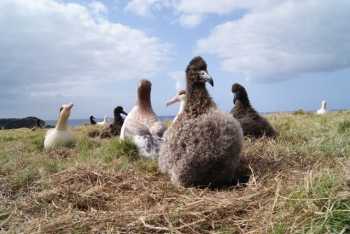Tomohiro Deguchi (Yamashina Institute for Ornithology, Division of Avian Conservation, Chiba, Japan) and Japanese and USA colleagues write in the journal Oryx on the results of their pioneering translocation and hand-feeding of Short-tailed Albatross Phoebastria albatrus chicks in an attempt to establish a new breeding colony on Mukojima Island.
The paper’s abstract follows:
“Many endemic species, particularly those on remote islands, have been driven to extinction or near extinction by anthropogenic influences. The short-tailed albatross Phoebastria albatrus once numbered in the millions but was thought to be extinct by the mid 20th century. Albatrosses, of the family Diomedeidae, are among the most threatened birds globally as a result of commercial exploitation, introduced predators, and mortality in commercial fisheries. We applied an experimental approach over 5 years to evaluate the translocation and hand-rearing of albatross chicks by comparing growth, physiological health indices, post-fledging survival, and migration patterns with a control group of naturally reared chicks in the source population. Hand-reared chicks had comparable or superior health and similar rates of immediate post-fledging mortality (15%), with mortality strongly female-biased in both groups. Hand-reared birds had longer post-fledging drift periods before attaining sustained flight (also female-biased) but comparable, albeit somewhat wider ranging, migration patterns to naturally reared chicks during their first 6 months at sea. Recruitment to the translocation site of a breeding pair that included a hand-reared bird occurred within 5 years of the first translocation. Success will ultimately depend on continued recruitment and breeding over the coming decades, given delayed breeding in these long-lived species. The results to date, however, have exceeded initial expectations and can inform potential reintroductions of other long-lived, migratory avian species with strong natal philopatry, and reintroductions of native species to former breeding islands.”

Translocated Short-tailed Albatross chicks get fat among adult decoys
on Mukojima Island; photograph by Tomohiro Deguchi
With thanks to Tomohiro Deguchi.
Reference:
Deguchi, T., Suryan, R.M., Ozaki, K., Jacobs, J.F., Sato, F., Nakamura, N. & Balogh, G.R. 2013. Translocation and hand-rearing of the short-tailed albatross Phoebastria albatrus: early indicators of success for species conservation and island restoration. Oryx The International Journal of Conservation.
John Cooper, ACAP Information Officer, 29 November 2013

 English
English  Français
Français  Español
Español